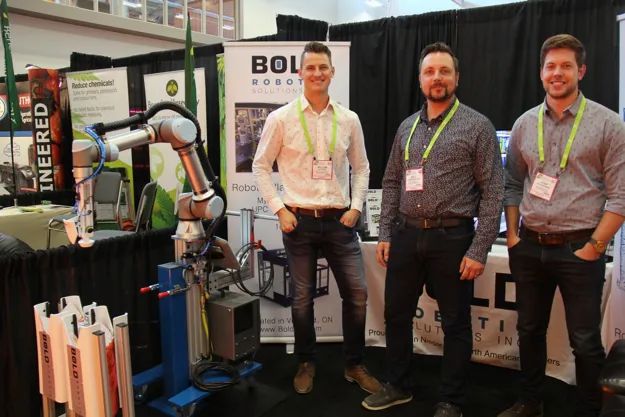With no background in the horticulture industry but being surrounded by many greenhouses in the Niagara region, Canada (ON), automation experts Willem Bijlsma and Bill VandenOever started Bold Robotic Solutions Inc. 2 years ago. "We noticed that greenhouses still make use of a lot of manual labor. However, as labor costs are increasing and - more importantly - as it is becoming more of a challenging to get labor in, automation could offer a solution." With this idea, they got together and established the company on October 31, 2017. They created a high-speed packaging robot and are currently working on an improved version and expanding the use of the machine in the process.

Willem Bijlsma, Bill Vandenoever and Joshua Schuurman at the Canadian Greenhouse Conference 2019
"The reactions from the industry were great", says Bill VandenOever, the in-house Mechanical Designer. After setting up the business with his long-time colleague Willem Bijlsma - responsible for Electrical Design and Automation - they started to contact growers and experts. "Everyone is so helpful and collaborative, all are looking for ways to improve the industry in general. We are very grateful to be able to work closely with people like Sunrise Greenhouses, and Pioneer Flower Farms, who have played a key role in where we are today." Also, at the Canadian Greenhouse Conference that took place earlier this month, Bold exhibited for the first time and received a lot of positive reactions and interest.
Replacing four people
After talking with many industry members and doing a lot of research and tests, they created their first robot in their first year: the high-speed packaging robot. "Every three seconds a sleeved plant, with mylar applied and UPC sticker attached, is coming down the line. This robot replaced about four people and seems to be more consistent than manual labor", says VandenOever.
Pot sizes 10-15 cm
But can it handle the large diversity of plants the growers are growing? "The robot can sleeve and pack many different plants in the pot sizes ranging from 10 to 15 cm - and around 80% of the products produced in this area fit in this range. Mums, daffodils, tulips, hyacinth, shrubbery trees and several more crops that are all between that pot size we've trialed, and when there is a new product, we will just test it again." Changing the settings to another pot size takes only about 10 minutes. Changing plant type and packaging options only takes a few seconds if the pot size stays the same.
First successful attempt
When seeing the robot at work, it seems quite straightforward, but it is said to be the first successful attempt of automating the packaging process. "We heard that more attempts have been done to create a packaging robot but have not been successful." The process of creating this robot wasn't free of obstacles either. "Handling the film was one of the most challenging parts, as we had to handle it carefully so that it would not tear, but feed into the machine to be cut reliably. Another challenge was once we introduced real plants, each plant variety had different requirements, and needed to be handled specific to it’s kind"
Next steps
The next step will be to improve the robot and look for new opportunities to support the industry with all automation quests, explains VandenOever. "We hired a new employee and we are currently fine-tuning our packaging robot and creating a 2.0 version of it. This version will have better motion control, so it will better handle the plants with the optimized design, as well as added functionality such as the ability to place UPC stickers on either the side or the bottom of the plant. On top of that, we are trying to extend the automation solutions in the post-harvest process. For example, we're talking to several internal logistics suppliers to look for options to connect their internal logistics system with ours. Then, the plants that come from the greenhouse can automatically be put on our packaging line."
VandenOever and his colleague are seeing more opportunities for greenhouse growers to optimize their processes with automation. One such development is a Production Monitoring system that measures the cycle rate of existing equipment, and logs the information within their developed software, and compare this data with the grower’s targets and requirements. "This way, the employees can work towards a certain goal, which improves productivity. In turn, everything will be tracked, so results can be better monitored." Another project they are working on is called a “Watchdog” Monitoring System, which consists of an array of sensors, and logic to track the movement of products on a conveyor and to determine if there is a disruption in the flow of products, the “Watchdog” will sense and react. This allows the operator to focus on the task at hand rather than having to continue watching the plants move from one area to another.
Also important to these 'newbies' in the horticulture industry is to make solutions that are available to every type of grower. "The smaller growers often say that they won't be able to justify the cost to automate, but we are eager to look for solutions that will benefit them too."
For more info rmation
rmation
Robotic Solutions Inc.
Bill Vandenoever
Email: [email protected]
www.boldrs.com
